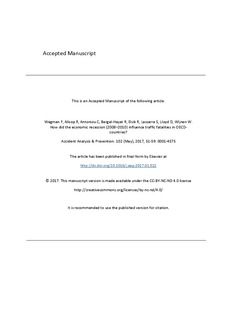| dc.contributor.author | Wegman, Fred | |
| dc.contributor.author | Allsop, Richard | |
| dc.contributor.author | Antoniou, Constrantionos | |
| dc.contributor.author | Bergel-Hayat, Ruth | |
| dc.contributor.author | Elvik, Rune | |
| dc.contributor.author | Lassarre, Sylvain | |
| dc.contributor.author | Lloyd, Daryl | |
| dc.contributor.author | Wijnen, Wim | |
| dc.coverage.spatial | Great Britain, Sweden | nb_NO |
| dc.date.accessioned | 2019-12-20T09:01:37Z | |
| dc.date.available | 2019-12-20T09:01:37Z | |
| dc.date.created | 2017-05-16T12:19:45Z | |
| dc.date.issued | 2017-04-14 | |
| dc.identifier.citation | Accident Analysis and Prevention. 2017, 102 (May), 51-59. | nb_NO |
| dc.identifier.issn | 0001-4575 | |
| dc.identifier.uri | http://hdl.handle.net/11250/2634226 | |
| dc.description.abstract | This paper presents analyses of how the economic recession that started in 2008 has influenced the number of traffic fatalities in OECD countries. Previous studies of the relationship between economic recessions and changes in the number of traffic fatalities are reviewed. Based on these studies, a causal diagram of the relationship between changes of the business cycle and changes in the number of traffic fatalities is proposed. This causal model is tested empirically by means of multivariate analyses and analyses of accident statistics for Great Britain and Sweden. Economic recession, as indicated both by slower growth of, or decline of gross national product, and by increased unemployment is associated with an accelerated decline in the number of traffic fatalities, i.e. a larger decline than the long-term trend that is normal in OECD countries. The principal mechanisms bringing this about are a disproportionate reduction of driving among high-risk drivers, in particular young drivers and a reduction of fatality rate per kilometre of travel, probably attributable to changes in road user behaviour that are only partly observable. The total number of vehicle kilometres of travel did not change very much as a result of the recession. The paper is based on an ITF-report that presents the analyses in greater detail. | nb_NO |
| dc.language.iso | eng | nb_NO |
| dc.publisher | Elsevier | nb_NO |
| dc.rights | Attribution-NonCommercial-NoDerivatives 4.0 Internasjonal | * |
| dc.rights.uri | http://creativecommons.org/licenses/by-nc-nd/4.0/deed.no | * |
| dc.title | How did the economic recession (2008–2010) influence traffic fatalities in OECD-countries? | nb_NO |
| dc.title.alternative | How did the economic recession (2008–2010) influence traffic fatalities in OECD-countries? | nb_NO |
| dc.type | Journal article | nb_NO |
| dc.type | Peer reviewed | nb_NO |
| dc.rights.holder | © 2017 Elsevier Ltd. All rights reserved. | nb_NO |
| dc.description.version | submittedVersion | nb_NO |
| cristin.unitcode | 7482,2,1,0 | |
| cristin.unitname | Sikkerhet og tiltak | |
| cristin.ispublished | true | |
| cristin.fulltext | preprint | |
| cristin.qualitycode | 1 | |
| dc.identifier.doi | 10.1016/j.aap.2017.01.022 | |
| dc.identifier.cristin | 1470487 | |
| dc.source.journal | Accident Analysis and Prevention | nb_NO |
| dc.source.volume | 102 | nb_NO |
| dc.source.issue | May | nb_NO |
| dc.source.pagenumber | 51-59 | nb_NO |

